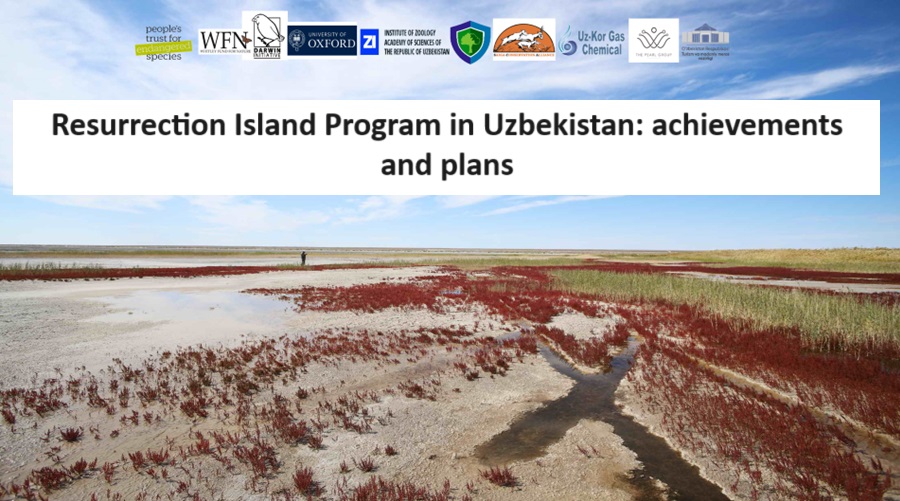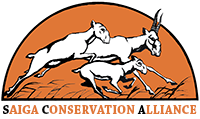
On the first day of spring, a round table was held in Muynak on the current results and future plans of the Resurrection Island program, carried out with the participation of the Saiga Conservation Alliance, the Institute of Zoology of the Academy of Sciences of the Republic of Uzbekistan at the University of Oxford (UK), the Ministry of Ecology of the Republic of Uzbekistan, the Research Institute for Tourism Development, OOO The Perl Group and JV Uz-Kor Gas Chemical LLC with the support of the British funds WFN, Darwin Initiative, PTES. The objectives of the program are: 1) conservation of biodiversity through the creation of a protected natural area; 2) assistance in developing sustainable sources of income for local communities; 3) technical support to the oil and gas sector to mitigate impacts on biodiversity.
All program activities take place on the territory of former islands and the dried bottom of the Aral Sea, as well as in the city of Muynak and nearby villages. During the round table, the main results of the program were presented, primarily the creation of the Aralkum National Natural Park. The national park with an area of 1 million hectares was created on the lands of the Muynak forestry enterprise and is a complex of unique landscapes where more than 300 species of vertebrates and higher vascular plants are found. In order to understand the value of this territory, it is enough to say that such rare species of animals as saiga, caracal, flamingo, birds of prey, steppe tortoise and others live here.
The state of the animal world was discussed in a presentation by a specialist from the Institute of Zoology, Academy of Sciences of the Republic of Uzbekistan, Alexander Esipov, who raised not only the issues of preserving rare species, but also spoke about ancient animals, whose fossilized remains can be found on the former islands of the Aral Sea and its exposed bottom – these are the ancestors of marine hedgehogs, squids (belemnites), mollusks, brachiopods. During the discussion, issues were discussed about strengthening protection and creating watering places for saiga and other animal species. The representative of the khokimiyat – deputy khokim for environmental issues Batyrbek Utiniyazov asked a question about the possibility of reintroducing rare ungulates on the territory of Aralkum, for example, the kulan.
The head of the laboratory “Records and cadastre of rare species of animals” of the Institute of Zoology, Academy of Sciences of the Republic of Uzbekistan, Elena Bykova, shared the specific results of the three main directions of the project. Particular emphasis was placed on the issues of selection and allocation of land, carrying out functional zoning of the Aralkum National Park, which is extremely important both for preserving the fragile nature of Aralkum and for the development of local communities and industry. A strictly protected area (nuclear zone) is intended to preserve hotspots of biodiversity, areas critical for the existence of animal and plant complexes. In the recreational area, it is possible and necessary to develop sustainable forms of tourism, such as eco-tourism, astrotourism, etc. The project supports local people through the creation of a tourist route, training Muynak residents in such specialties as hotel business owner, guide, tourism operator. In the area of economic and other activities, the interests of development projects and biodiversity conservation come into contact. A long-time partner of the project is Uz-Kor Gas Chemical, a chemical company that processes natural gas from the Uchsai field. Not long ago, the exploitation of natural gas from the Western Aralkum field began on the territory of Aralkum. Project staff carry out extensive consulting work and training on international approaches to mitigating the impact of these industries on the biodiversity of the Aral Sea region by applying the principle of “zero losses to nature and beyond.”
An assessment of the socio-economic situation, needs and interests of residents, as well as their proposals for the development of the region in order to obtain a comprehensive picture of the current situation in Muynak and determine priority areas for development was made by Olga Esipova, a member of the Saiga Conservation Alliance, based on a primary sociological survey and test questionnaire held during the Round Table in Muynak.
This event was accompanied by an open discussion between the round table participants – employees of the Muynak khokimiyat, the regional branch of the Ministry of Ecology, the Aralkum National Park, the eco-museum and other residents of Muynak. The expert group examined the prospects for the development of the area, noting that the national park will help not only preserve nature, but also create new jobs for the population.

Participants of the Round Table in Muynak

Elena Bykova discusses the results of the Resurrection Island program

Olga Esipova discusses the results of a sociological survey

Conducting a test survey among Round Table participants
Photos by Alexander Esipov
